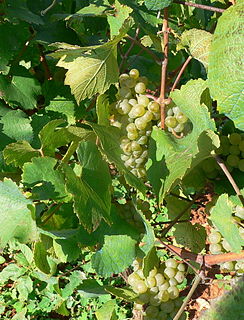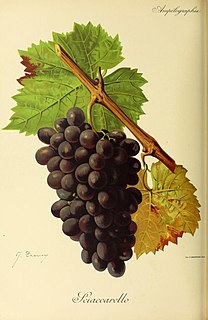
Malvasia is a group of wine grape varieties grown historically in the Mediterranean region, Balearic Islands, Canary Islands and the island of Madeira, but now grown in many of the winemaking regions of the world. In the past, the names Malvasia, Malvazia, and Malmsey have been used interchangeably for Malvasia-based wines; however, in modern oenology, "Malmsey" is now used almost exclusively for a sweet variety of Madeira wine made from the Malvasia grape. Grape varieties in this family include Malvasia bianca, Malvasia di Schierano, Malvasia negra, Malvasia nera, Malvasia nera di Brindisi, Malvasia di Candia aromatica, Malvasia odorosissima, and a number of other varieties.

Aglianico is a black grape grown in the southern regions of Italy, mostly Basilicata and Campania. It is considered with Sangiovese and Nebbiolo to be one of the three greatest Italian varieties. Aglianico is sometimes called "The Barolo of the South" due to its ability to produce highly refined, complex fine wines like the famous Piedmont wine, Barolo.

Vernaccia is a white wine grape that is found in many Italian wines but is most commonly associated the Tuscan wine Vernaccia di San Gimignano. Ampelographers have determined that the Vernaccia vine has many clonal varieties but is unrelated to some Italian vines known as "Vernaccia" such as the Sardinian varieties used in the Sherry-like wine Vernaccia di Oristano, the Trentino-Alto Adige/Südtirol red wine grape known as Vernatsch or the black grape used in the red sparkling wine of the Marche Vernaccia di Serrapetrona. A possible reason for this is that the root of the name Vernaccia translates to "vernacular" and can apply to any local grape.

Sciacarello is a red Italian wine grape variety that is grown primarily in Corsica. It is most noted for the wines that come from Ajaccio which tend to be highly perfumed. It is also associated with wines from Calvi, and in the Sartène region around Propriano. The grape is normally blended and rarely made into a varietal wine. Sciacarello is believed to be a parent vine of the Ligurian-Tuscan wine grape, pollera nera. Di Vecchi Staraz, Bandinelli, Boselli, This, Boursiquot, Laucou, Lacombe, and Varès (2007) showed that Sciaccarello and another Corsican variety Malvasia Montanaccio as well as Tuscan varieties Biancone, Caloria, Colombana Nera, and Pollera Nera have genetic ties to Mammolo.

Gaglioppo is a red wine grape that is grown in southern Italy, primarily around Calabria. The vine performs well in drought conditions but is susceptible to oidium and peronospora. The grape produces wine that is full-bodied, high in alcohol and tannins with a need for considerable time in the bottle for it to soften in character. It is sometimes blended with up to 10% white wine.

Piemonte wine is the range of Italian wines made in the region of Piedmont in the northwestern corner of Italy. The best-known wines from the region include Barolo and Barbaresco. They are made from the Nebbiolo grape. These wines are ideal for storage and a well-aged Barolo for instance may leave a feeling of drinking velvet because the tannins are polished and integrated more and more into the wine. As the wine matures the colour becomes more brownish and rust-red.
Mammolo is a red Italian wine grape that is planted primarily in Tuscany. While its use has been diminishing, Mammolo was historically included in the blended Sangiovese-based wines of Chianti where it contributed a distinctive violet or mammole aroma. In addition to small plantings in the Chianti zone, Mammolo can be found in the Vino Nobile di Montepulciano region of Tuscany and in scattered vineyards throughout Central Italy.
Uva Rara is a red Italian wine grape variety that is grown in the Piedmont and Lombardy wine regions of northern Italy. The grape is a permitted blending variety along with Nebbiolo in the Denominazione di Origine Controllata e Garantita (DOCG) wines of Ghemme. In the Denominazione di Origine Controllata (DOC) wine region of Oltrepò Pavese the grape is often blended with Barbera and Croatina. While Uva Rara's name means "rare grape" in Italian, the variety is actually widely planted with 608 hectares of the vine recorded in Italy in 2000.
Fortana is a red Italian wine grape variety grown primarily in the Emilia–Romagna region of northern Italy. A permitted grape variety in several Denominazione di origine controllatas (DOCs), mostly in Emilia, Fortana mostly contributes tartness and acidity in red blends.
Pollera nera is a red Italian wine grape variety that is grown primarily in the Liguria wine region and northwest Tuscany. Ampelographers believe that the vine has a very long winemaking history but it is rarely seen today. It is believed to have been descended from the Chianti wine grape Mammolo and the Corsican wine grape Sciacarello which would make it a half-sibling of Colombana nera.

Mastroberardino is an Italian winery located in Atripalda, in Provincia di Avellino, in the Campania region. Founded in 1878, the winery is known for its production of Taurasi DOCG as well as its ampelography work in identifying and preserving ancient grape varieties like Greco and Fiano. The work of the Mastroberardino family, particularly Antonio Mastroberardino, in this field is widely respected and Antonio is often called "The Grape Archaeologist".
Abbuoto is a red Italian wine grape variety that is grown primarily in the Lazio region of central Italy. Historically the grape was believed to be responsible for the Ancient Roman wine Caecubum that was praised by writers such as Pliny the Elder and Horace but historians and wine experts such as Jancis Robinson and Julia Harding note that connection is likely erroneous.
Rossola nera is a red Italian wine grape variety that has been growing in the Valtellina region of Lombardy since at least the 17th century. In 2004 DNA profiling determined that the grape has a parent-offspring relationship with the Piedmont wine grape Nebbiolo though which variety is the parent and which is the offspring is not yet clear. However, most ampelographers believe that Nebbiolo is likely the parent variety since written records in Piedmont have noted Nebbiolo being grown since at least the 13th century.
Rossignola is a red Italian wine grape variety that is grown in the Veneto wine region of northeast Italy. The variety was first mentioned growing in the province of Verona in the early 19th century and today is a permitted blending variety in several Denominazione di origine controllata (DOC) wines of the Veneto including Bardolino and Valpolicella.
Bracciola nera is a red Italian wine grape variety that is primarily found in the Liguria and Toscana wine regions of western Italy. The only Denominazione di origine controllata (DOC) that Bracciola nera plays a significant role is in the Colli di Luni DOC of Ligura where the grape is permitted to be blended with Sangiovese, Canaiolo, Pollera nera, Ciliegiolo, Vermentino nero and other varieties. A late-ripening variety, Bracciola nera usually contributes acidity to blends.
Colombana nera is a red Italian wine grape variety that is grown in Emilia-Romagna and Tuscany. Despite similarities in name, the grape did not get its name from nor is it grown in the San Colombano al Lambro region of Lombardy nor is it permitted in the Denominazione di origine controllata (DOC) wine of the same name. Rather, ampelographers believe that Colombana nera is named after the Abbey of San Colombano located in the commune of Bobbio in the Piacenza province of Emilia-Romagna where the grape has had a long history of cultivation.
Grisa nera is a red Italian wine grape variety that is grown in the Piedmont wine region of northwest Italy where it is used in both winemaking and as a table grape. The grape is most often used as a minor blending component with wines made from Barbera, Neretta Cuneese and Plassa.
Piccola nera is red Italian and Slovenian wine grape variety that is grown in the province of Trieste within the Friuli-Venezia Giulia wine region and across the border in neighboring Slovenia where ampelographers believe that the grape originated. Piccola nera, whose name means "little black", tends to produce to light bodied red and rosé wines that are meant to be consumed young. It is a permitted variety in the Denominazione di origine controllata (DOC) wines of Carso where it is usually blended with Terrano and in Venezia Indicazione geografica tipica IGT classification where the grape can be used to make varietal wines.
Avarengo is a red Italian wine grape variety that is grown in the Piedmont wine region of northwest Italy where it is a permitted blending component in the Denominazione di origine controllata (DOC) wines of Pinerolese. Here the grape is usually blended with Avanà, Neretta Cuneese and other local red Piemontese varieties.
Barbera del Sannio is a red Italian wine grape variety that is grown in the Campania region of southern Italy. Despite the similarities in name and appearance, the grape has no close genetic relationship with the Piedmont wine grapes Barbera or Barbera bianca or the Sardinian wine grape Barbera Sarda and is, instead, more closely related to the Campanian varieties Casavecchia and Catalanesca and the Apulian grape Nero di Troia.







